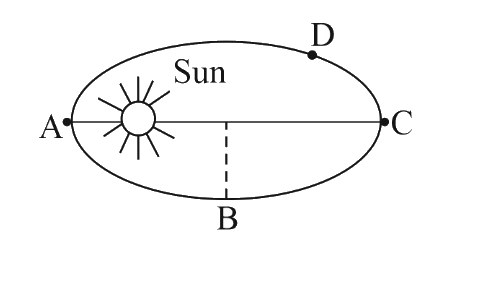The earth revolves around the sun in an elliptical orbit. It has a speed when it is at the minimum distance from the sun. When it is at the maximum distance from the sun, its speed is
The correct Answer is:B
To solve the problem of finding the speed of the Earth when it is at the maximum distance d2 from the Sun, we can use the principle of conservation of angular momentum. Here's a step-by-step solution:
Step 1: Understand the system
The Earth revolves around the Sun in an elliptical orbit. At the minimum distance d1 from the Sun, the speed of the Earth is v1. We need to find the speed v2 when the Earth is at the maximum distance d2.
Step 2: Apply the conservation of angular momentum
Since no external torque acts on the Earth-Sun system, the angular momentum is conserved. Therefore, we can write:
L1=L2
Where L1 is the angular momentum at distance d1 and L2 is the angular momentum at distance d2.
Step 3: Express angular momentum
The angular momentum L can be expressed in terms of linear velocity and distance from the Sun:
L=m⋅r⋅v
Where:
- m is the mass of the Earth,
- r is the distance from the Sun,
- v is the linear velocity.
Thus, we can write:
L1=m⋅d1⋅v1
L2=m⋅d2⋅v2
Step 4: Set the angular momentum equations equal
From conservation of angular momentum:
m⋅d1⋅v1=m⋅d2⋅v2
Step 5: Simplify the equation
Since the mass m of the Earth is constant and non-zero, we can cancel it from both sides:
d1⋅v1=d2⋅v2
Step 6: Solve for v2
Rearranging the equation to solve for v2:
v2=d1d2⋅v1
Conclusion
Thus, the speed of the Earth at the maximum distance d2 from the Sun is given by:
v2=d1d2⋅v1
The Earth revolves around the Sun in an elliptical orbit. At the minimum distance d1 from the Sun, the speed of the Earth is v1. We need to find the speed v2 when the Earth is at the maximum distance d2.
Since no external torque acts on the Earth-Sun system, the angular momentum is conserved. Therefore, we can write:
The angular momentum L can be expressed in terms of linear velocity and distance from the Sun:
- m is the mass of the Earth,
- r is the distance from the Sun,
- v is the linear velocity.
L2=m⋅d2⋅v2
From conservation of angular momentum:
Since the mass m of the Earth is constant and non-zero, we can cancel it from both sides:
Rearranging the equation to solve for v2:
Thus, the speed of the Earth at the maximum distance d2 from the Sun is given by:
Topper's Solved these Questions
- GRAVITATION BOOK - MARVEL PUBLICATIONCHAPTER - GRAVITATION EXERCISE - TEST YOUR GRASP -2
20 Videos
- ELECTROSTATICSBOOK - MARVEL PUBLICATIONCHAPTER - ELECTROSTATICSEXERCISE - TEST YOUR GRASP
20 Videos
- INTERFERENCE AND DIFFRACTIONBOOK - MARVEL PUBLICATIONCHAPTER - INTERFERENCE AND DIFFRACTIONEXERCISE - TEST YOUR GRASP
20 Videos
Similar Questions
Knowledge Check
The earth revolves round the sun in an elliptical orbit. Its speed
Agoes on decreasing continuouslyBgreatest when it is closest to the sunCgreatest when it is farthest from the sunDconstant at all the points on the orbitA satellite revolves around the earth in an elliptical orbit. Its speed is
Asame at all points on the orbit.Bgreatest when it farthest from the earthCgreatest when it is closest to the earthDgreatest neither when it is closest nor when it is farthest from the earth, but at some other point.When the earth revolves round the sun in an elliptical orbit, its kinetic energy is
Ago on decreasing continuouslyBgreatest when it is closest to the sunCgreatest when it is farthest from the sunDconstant at all point on the orbit
A satellite revolves around the earth in elliptic orbit ,its speed is :
View SolutionThe earth is at its maximum distance from the Sun on :
View SolutionA planet moves around the sun in an elliptical orbit. When earth is closest from the sun, it is at a distance r having a speed v. When it is at a distance 4r from the sun its speed will be:
View SolutionWhat is called the minimum distance from the Sun in a planet in its orbit?
View SolutionWhat is called the maximum distance from the Sun in a planet in its orbit?
View Solution

